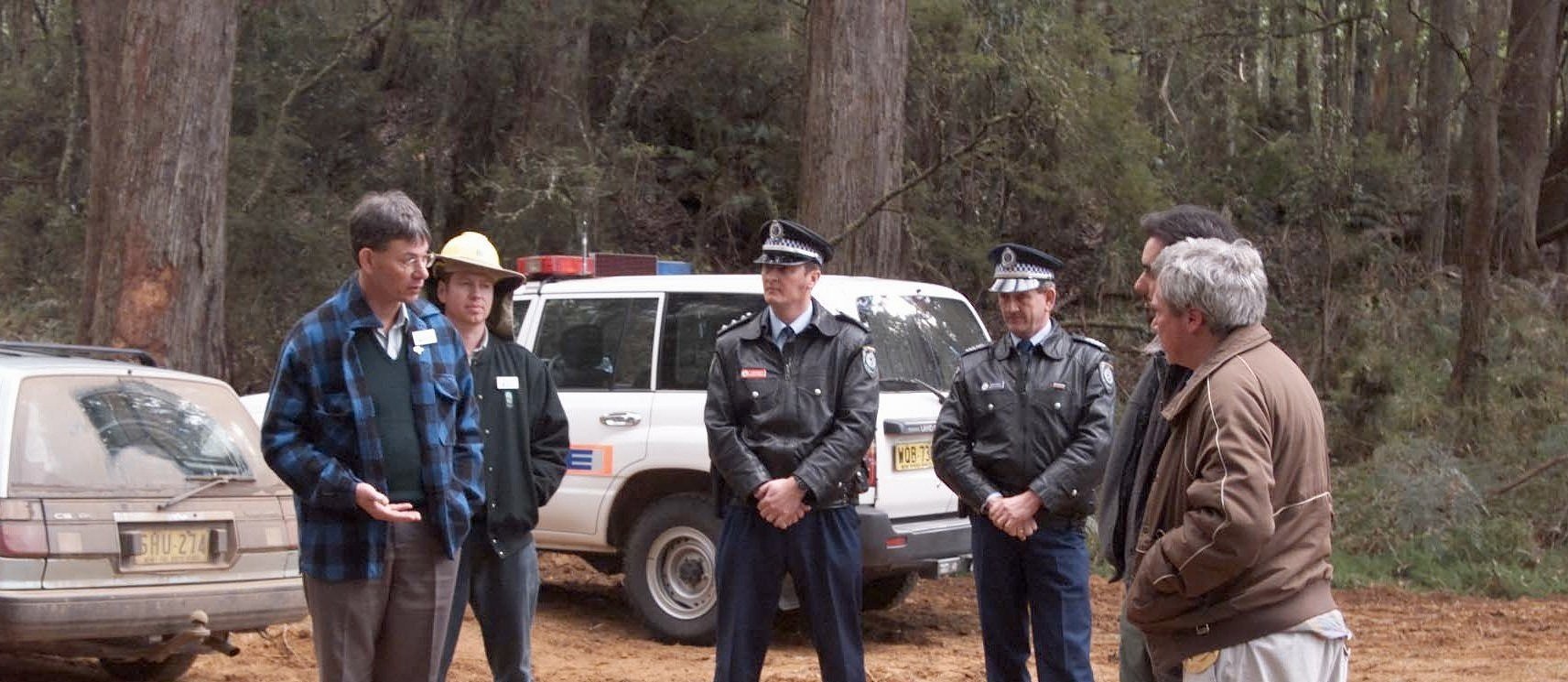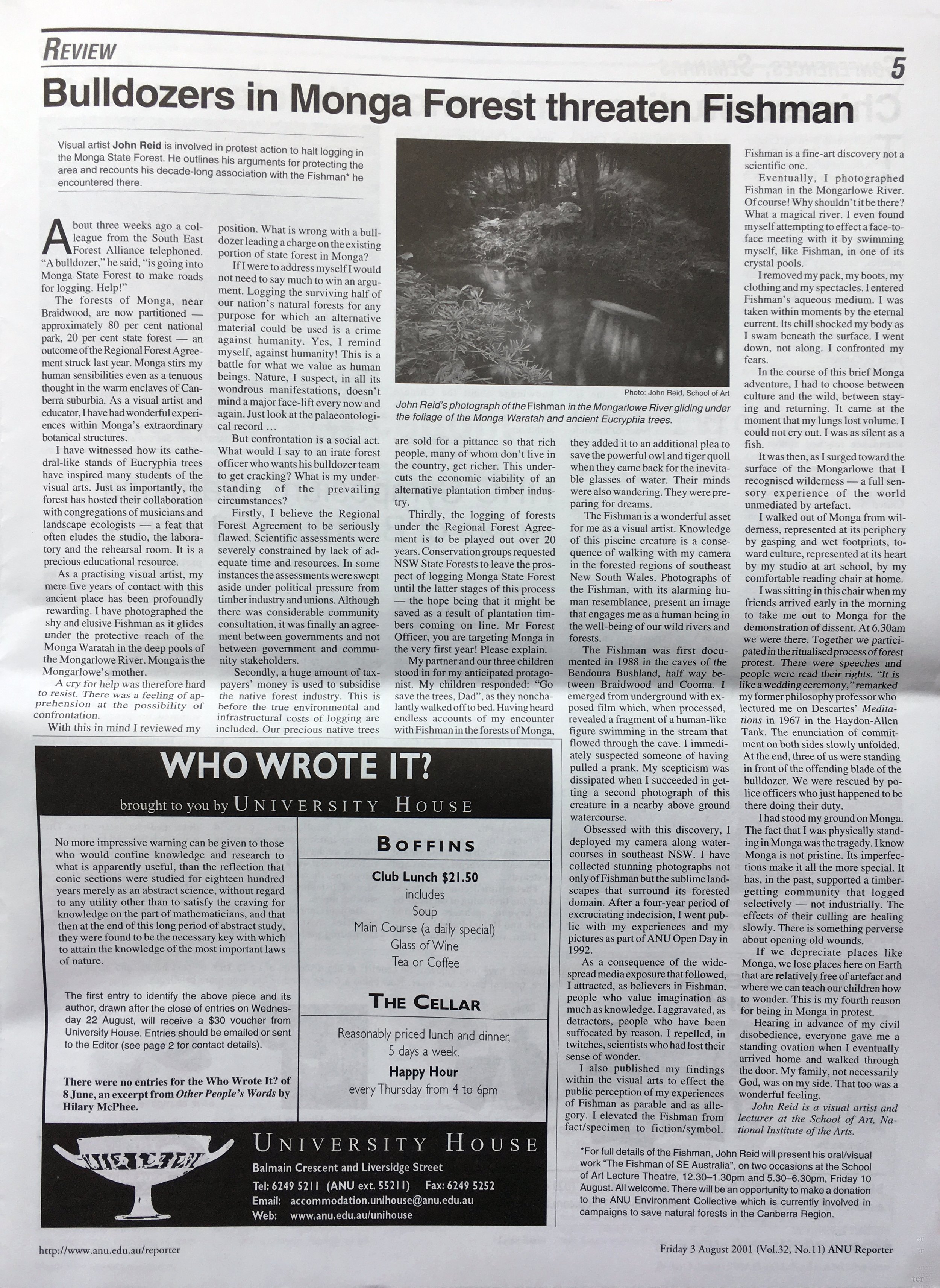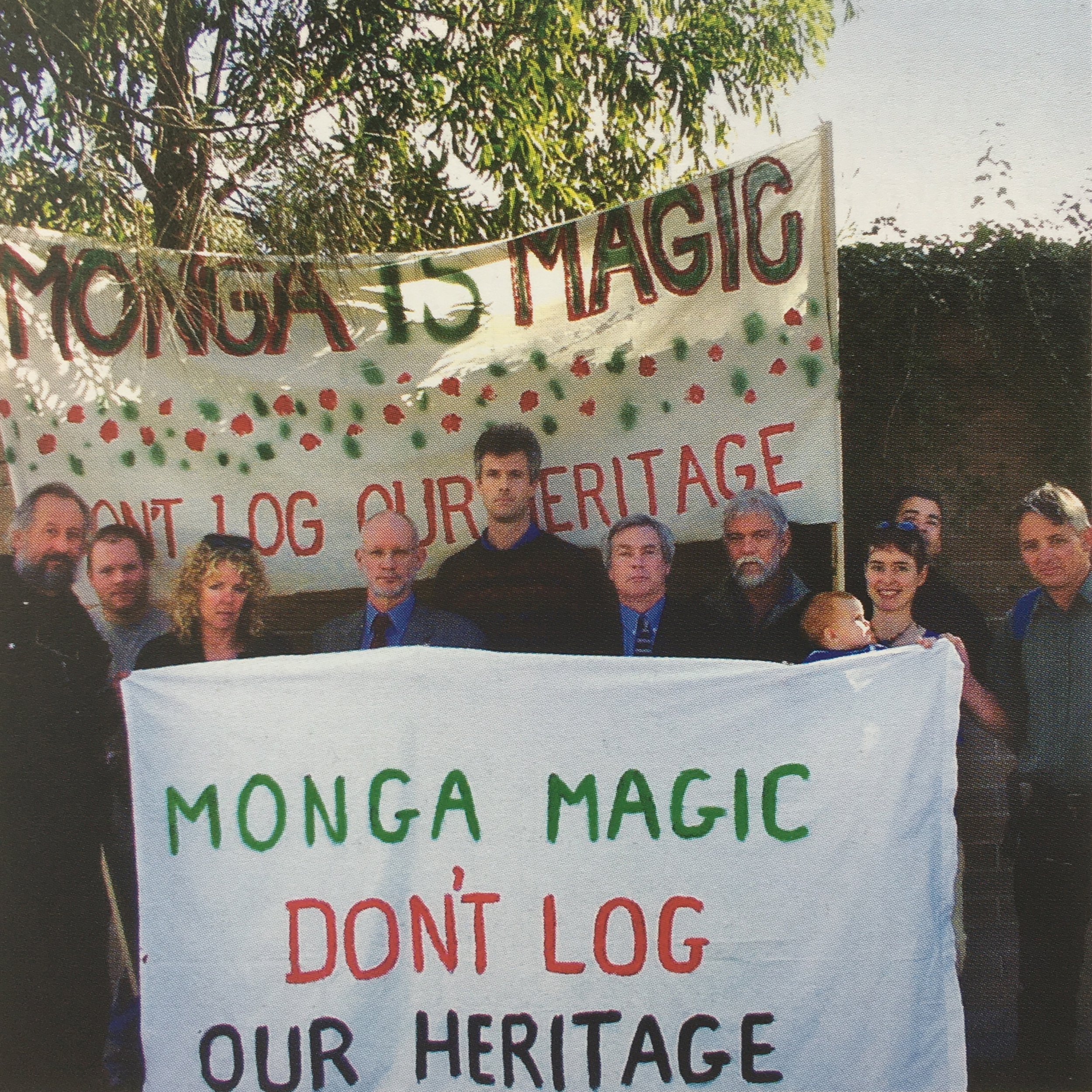Community Campaign to save the Forests of Monga / 1
First protest action, July 3-16 2001, against construction of logging roads in Monga State Forest following the Regional Forest Agreement

3 July 2001 From left: Ian Barnes and colleague from NSW Forests, local constabulary, Andrew Wong and Noel Plumb engaged in the first action protest against construction of logging roads in Monga State Forest following the Regional Forest Agreement
Bay Post / Southern Star July 4 2001. Protesters in front of bulldozer: from left Andrew Wong, John Reid, Peter Herbst, Noel Plumb and Harry Lang
ANU Reporter (August 3, 2001). John Reid’s account of the 3 July 2001 protest action in Monga State Forest.
Batemans Bay Court 16 July 2001. Reid, Lang and Plumb (centre) with supporters after court proceedings.
Photograph from Monga intacta (Ed Robyn Steller, 2005) Page 122.
16 July 2001. Batemans Bay. Statement by John Reid. Tendered in the Magistrate’s Court.
It was in my capacity as a visual artist and educator that I stood my ground on Tuesday 3rd July, in front of a NSW Forests bulldozer deployed to make roads in Monga State Forest for the purpose of logging.
(Tender photograph of Bulldozer and road construction taken in Monga, 3rd July, 2001.)
I stood my ground to send a desperate message to the Governor of NSW, the NSW Government, its Minister for Forests, Mr Kim Yeadon, concerning the impending destruction of the cultural heritage of Monga State Forest as a result of NSW Forests' industrial intrusion on the site. If we depreciate the natural qualities of places like Monga State Forest we lose places, here on earth, that are relatively free of artefact, and where we can teach successive generations how to wonder.
(Tender photographs of the depreciation of the Monga Forest, 3rd July, 2001 including the destructive impact of the road making itself, and the first side effect of the road construction - the removal of tree ferns from the forest.)
As an artist and teacher, I have experienced the inspirational and educational value of the forests of Monga. As a teacher I have witnessed visual arts students from the School of Art at The Australian National University draw inspiration from the forest of Monga for making art in diverse media such as painting, drawing, sculpture, photography, textiles and glass. I have witnessed visual arts students work together in Monga with landscape ecology students from the Geography Department also from The Australian National University. The ecology students shared the outcome of their scientific investigations in the forest with the art students and they, in turn, shared their skills in the aesthetic communication of knowledge. Their visual art imagery and scientific text came together in the form of a public exhibition and a limited-edition hand produced artist book one of which was presented personally to the ACT Minister of Tourism and the Arts at the opening of the exhibition in Canberra.
(Tender catalogue of Monga Exhibition, Photospace Gallery, School of Art, ANU).
I have also witnessed visual arts students work in Monga together with student musicians and composers from the Canberra School of Music at The Australian National University. Both groups engaged in fieldwork in Monga as a source of inspirational experience for the composition of musical scores and the production of non-traditional musical instruments with a view to ensemble performances.
(Tender CD recording of impromptu performance "The Colours of Monga" performed at University House, Australian National University, for the joint meeting of the National Environment Education Council and members of the ANU on 31st May, 2001 and broadcast on The Science Show, ABC Radio National on 11th June, 2001).
As an artist, I have photographically documented the forests of Monga and have exhibited these photographs as mural size prints in exhibitions - both regionally in Canberra and overseas in Japan and Poland - that have indirectly promoted the wilderness qualities of the landscapes of SE NSW.
(Tender 10x8 inch contact print of one of these images taken in Monga)
As an artist, I too have found inspiration in Monga and have experienced the power of this ancient place to bring to mind the eternal narrative themes of human kind - themes that enunciate in various ways the symbiotic relationship between the human species and the natural environment.
The Fishman of SE Australia is one such story which recounts my experiences with a piscine creature of alarming human likeness in wilderness watercourses in SE NSW. It was no surprise to me when I eventually photographed this creature, The Fishman, in the Mongarlowe River which has its headwaters in the forests of Monga. My experiences of Fishman constitute a wonderful assert for me as a visual artist. I have, I believe, an obligation to tell my story of Fishman whenever the opportunity arises. I have done this for more than 10 years and the story has, as a result of mass media exposure, reached hundreds of thousands of Australians. My encounters in Mongarlowe River headwaters are a feature of the narrative.
(Tender article 26th July, 1993, by Maria Taylor, Environment Correspondent for The Canberra Times).
I last told the story to approximately 350 delegates at the Australian Photographic Society's Annual Conference in Canberra in November last year and presented a paper on the narrative at an international conference on Systems Research in the Arts, in Germany, a little earlier in August of the same year. There was tremendous interest in Fishman and the wild forests of its domain at the conference. You see, Fishman is a fine art discovery, not a scientific one.
(Tender Conference handout with a photographic documentation of the Fishman in Monga in the Mongarlowe River)
I have raised these details to demonstrate the extent of my professional association with Monga and its wonderful forests. I personally believe that no native forest should be logged for any purpose for which an alternative material can be used. These points of view together with other compelling conservation arguments for the preservation of Monga State Forest, led to my protest action in Monga on Tuesday 3rd July that subsequently brings me before this court.
As Ghandi convincingly demonstrated, civil disobedience is an effective tactic in the promotion of an ethical quest. I believe the preservation of our natural forests to be an ethical quest. I am not in any way disrespectful of the law. Quite the contrary. I subscribe to the view advanced by the philosopher Wittgenstein that laws serve to enunciate meaning and their wanton breaking only serves to destroy that meaning. My stand in Monga was not a wanton act. It was a carefully considered act. What is at issue in Monga subscribes to a higher jurisdiction of justice than that which informs a statuary Forestry Regulation.
I apologise for inconveniencing this court but request its understanding, in the knowledge that half our precious natural forests are already gone, of the need for drastic and direct action to save what is left.July 200116 July 2001
Community Campaign to save the Forests of Monga / 2
Subsequent actions September/November 2001 by a group of protesters - ‘The South East Forest Rescue’. For a full account see ‘The Monga Actions’ by Sooty in Monga intacta (ed Robyn Steller, 2005) Pages 126-29.





